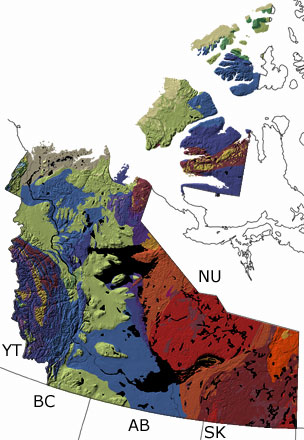

Northwest Territories, Canada |
|||||||||||||||||||||||||||||||||||||||||||||||||||||||||||||||
|
|||||||||||||||||||||||||||||||||||||||||||||||||||||||||||||||
Paleontology and geologyThe Precambrian: Precambrian rocks in Northwest Territories include igneous, sedimentary, and metamorphic rocks that record continental collisions and breakups, mountain-building, and volcanism over billions of years. Although they have varied histories, they all came together about 1.8 Ga to form part of the Canadian Shield, the core of the North American continent. Some of the oldest rocks on Earth are found in this territory, as well as fossils of some of the earliest multicellular animals (Ediacaran-type animals). The Paleozoic: Through the Paleozoic, the eastern and central parts of Northwest Territories were above sea level, and sediments eroding off the land were deposited in the shallow to deep seas that covered the rest of the territory. These warm waters were home to many different kinds of fish and a variety of invertebrates, some of which formed substantial reefs. In the Middle Paleozoic, continental collisions in the north pushed up parts of the Arctic Archipelago, and plants invaded the land. By the end of the era, most of the territory was uplifted. The Mesozoic: Aside from the western edge of the territory and some of the Arctic Islands, most of Northwest Territories was above sea level in the Mesozoic. Sediments eroding from the land were carried by rivers and deposited in deltas and shallow seas to the west and north. The climate became more temperate as the continent drifted north, and new invertebrate species could be found in the seas. In the Late Mesozoic, the Western Interior Seaway spread across the territory, bringing with it many species of fish, marine reptiles, aquatic birds, and invertebrates. By the end of the era, the seas drained away and most of the territory was raised up. The Cenozoic: Tectonic activity uplifted most of the Northwest Territories in the early Cenozoic. Plants now found only in warmer areas to the south once covered the entire territory, even north of the Arctic Circle. Their fossils are preserved in deposits from rivers, deltas, and lakes. At the end of the era, the climate cooled, and glaciers developed. They spread down from the mountains and the Arctic islands, forming the modern topography of the territory. Deposits on some of the islands contain marine fossils that testify to intervals of higher sea level between the glacial periods. |
|||||||||||||||||||||||||||||||||||||||||||||||||||||||||||||||
Links to more on Northwest Territories paleontology |
|||||||||||||||||||||||||||||||||||||||||||||||||||||||||||||||
|
Organizations | Education and Exhibits | Resources OrganizationsEducation and Exhibits Resources
|
|||||||||||||||||||||||||||||||||||||||||||||||||||||||||||||||
|
site tour |
about the site |
site map |
site credits |
page credits |
help |
FAQs |
contact |
||

